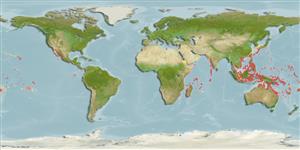>
Gobiiformes (Gobies) >
Gobiidae (Gobies) > Gobiinae
Etymology: Cabillus: Dutch, kabeljau = cod fish, a dish of cod mached (Ref. 45335).
More on author: Smith.
Environment: milieu / climate zone / depth range / distribution range
Écologie
marin récifal. Subtropical
Indo-Pacific: South Africa, Ryukyu Islands, and the east coast of northern Australia. Recently reported from Tonga (Ref. 53797).
Taille / Poids / Âge
Maturity: Lm ? range ? - ? cm
Max length : 4.0 cm TL mâle / non sexé; (Ref. 90102)
Description synthétique
Clés d'identification | Morphologie | Morphométrie
Épines dorsales (Total) : 6 - 7; Rayons mous dorsaux (Total) : 9; Épines anales: 1; Rayons mous anaux: 8. Characterized by semi-translucent whitish with short dark band below eye; head and body with irregular blackish spots and blotches; black markings on dorsal fins; sometimes with blackish pelvic and anal fins; rounded caudal fin; longitudinal scale series 28; absence of median predorsal scales; prepectoral area without scales; scaled prepelvic area; depressed head, head depth about 1.3 in head width; opening of gill restricted to base of pectoral pectoral fin; depth of body 4.5-5.3 in SL (Ref. 90102).
Inhabits sandy bottoms among coral reefs.
Life cycle and mating behavior
Maturities | Reproduction | Spawnings | Egg(s) | Fecundities | Larves
Masuda, H., K. Amaoka, C. Araga, T. Uyeno and T. Yoshino, 1984. The fishes of the Japanese Archipelago. Vol. 1. Tokai University Press, Tokyo, Japan. 437 p. (text). (Ref. 559)
Statut dans la liste rouge de l'IUCN (Ref. 130435)
Menace pour l'homme
Harmless
Utilisations par l'homme
Outils
Articles particuliers
Télécharger en XML
Sources Internet
Estimates based on models
Preferred temperature (Ref.
123201): 24.6 - 29.3, mean 28.2 °C (based on 2476 cells).
Phylogenetic diversity index (Ref.
82804): PD
50 = 0.5156 [Uniqueness, from 0.5 = low to 2.0 = high].
Bayesian length-weight: a=0.00708 (0.00333 - 0.01504), b=3.09 (2.92 - 3.26), in cm total length, based on LWR estimates for this (Sub)family-body shape (Ref.
93245).
Niveau trophique (Ref.
69278): 3.1 ±0.3 se; based on size and trophs of closest relatives
Résilience (Ref.
120179): Haut, temps minimum de doublement de population inférieur à 15 mois (Preliminary K or Fecundity.).
Fishing Vulnerability (Ref.
59153): Low vulnerability (10 of 100).
